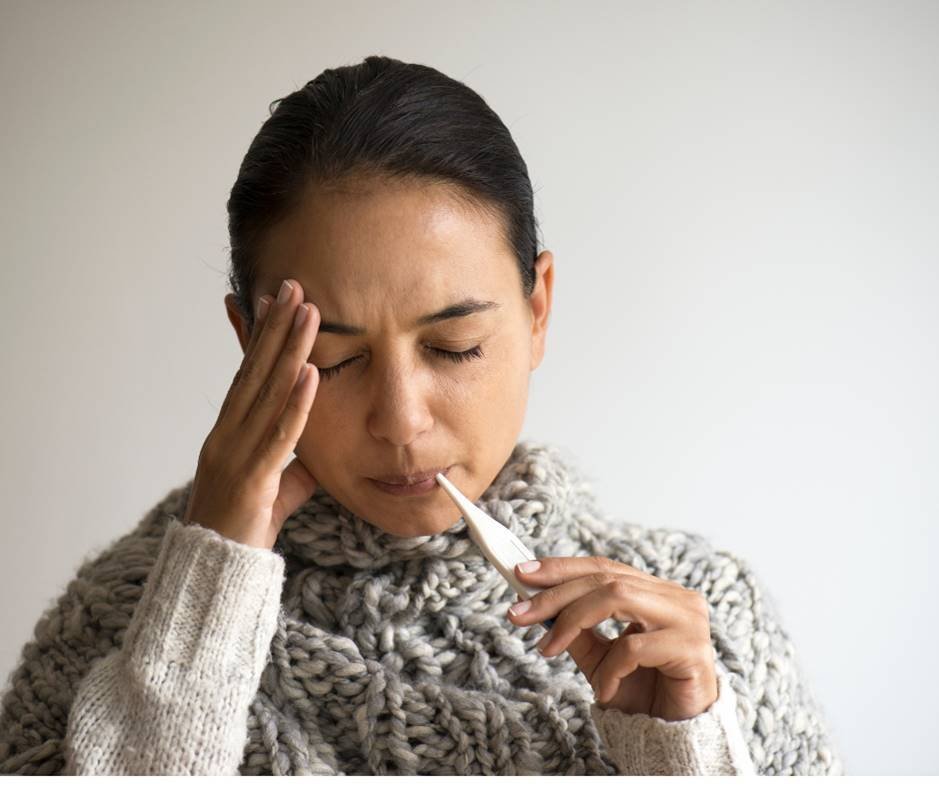It starts with a scratchy throat and stuffy nose before rapidly escalating into chills, body aches, and a spiking temperature. A fever caused by a cold virus is an all too common part of winter. While medications can help suppress some symptoms temporarily, your body’s immune system still needs to fight off the underlying infection. Supporting your body’s efforts with home remedies is an effective way to find natural fever and cold relief.
This comprehensive guide covers simple, research-backed remedies you can utilize at home to soothe a fever and related cold symptoms. We’ll explore natural options to:
- Lower your body temperature
- Relieve congestion and body aches
- Increase hydration and nutrition
- Boost your immune system’s germ-fighting abilities
Follow along to build your own fever-fighting action plan using ingredients from your kitchen, supplements, lifestyle measures, and OTC medications. We’ll also cover when it’s crucial to seek emergency care for a dangerously high fever. Arm yourself with these handy home remedies so you can swiftly tackle colds and fevers as they come this season. Let’s learn fever due to cold home remedies.
Soaking in Cool Water for Lowering a High Temperature
Spiking a fever is your body’s way of making itself inhospitable for the cold virus replicating inside you. But an excessively high fever over 104°F (40°C) can be dangerous if left unchecked. One of the safest and most effective ways to quickly lower a concerning fever is by soaking your body in cool water.
- For adults, take a lukewarm bath or shower until the fever drops below the danger zone. For children, give a sponge bath with room temperature water instead. The water temperature should be between 70–90°F (20-32°C).
- Alternatively, apply cool, damp washcloths to pulse points like wrists, neck, elbows, groin, and behind the knees. This can rapidly bring down a spiking fever.
These simple water therapy techniques work by enabling conductive heat loss. As long as you don’t induce shivering, they can safely lower body temperature without suppressing the immune response.

Soothing Steam for Stuffy Noses and Coughs: Fever Due to Cold Home Remedies
A fever often comes alongside congestion, coughs, and sinus pressure. Inhaling steam infused with herbs and essential oils can provide relief for these upper respiratory symptoms. The warm moisture loosens mucus secretions, calms inflammation, and clears congestion—all helpful when you’re stuffed up from a cold.
- Try adding eucalyptus, menthol, thyme, rosemary, peppermint or oregano oil to a bowl of steaming hot water. Drape a towel over your head and inhale the vapors for 5-10 minutes.
- For a nighttime steam before bed, add these herbs to a steamy shower and breathe deeply to clear your airways for sleep.
- Saline nasal sprays and rinsing can also relieve sinus congestion and dryness that worsens cold symptoms.
Sipping Hot Beverages to Soothe and Hydrate
When you have the chills from a spiking fever, sipping on warm liquids provides instant relief. Broths, teas, and electrolyte drinks also supply much-needed hydration during a fever’s dehydrating effects.
- Sip on bone, chicken or vegetable broth, which can help thin out mucus while delivering hydration and minerals.
- Drink soothing herbal teas with ingredients like ginger, lemon, honey, garlic, peppermint, licorice root, or thyme to ease cold and flu symptoms.
- Oral rehydration solutions like Pedialyte contain the ideal balance of electrolytes, sugars, and fluids for replenishing what’s lost through feverish sweating and mucus production.
A fever increases fluid needs significantly, so it’s vital to rehydrate frequently when you’re ill. Enhancing the taste and comfort of your drinks will encourage you to sip throughout the day.
Soothing Aches with Alternating Hot and Cold Therapy
Body aches are another common side effect of fever and viral illness. For natural relief, try alternating hot and cold therapy. The temperature extremes stimulate blood flow to reduce stiffness, pain, and inflammation.
- Apply a warm compress, heating pad, or hot water bottle to afflicted areas for 3 minutes, followed by an ice pack for 30 seconds.
- Repeat this hot-cold cycle 3 to 5 times, ending on cold. The contrasting temperatures provide drug-free pain and tension relief.
- Target areas like sore muscles, swollen sinuses, ears, headaches, and chest congestion.
Both heat and cold therapy boost circulation and can relax tight muscles when you’re feeling achy all over from a fever’s effects.

Warding Off Chills with Warmth and Spice
Uncontrollable shivering and shaking chills often accompany a fever’s climb. Bundling up in comfortable clothing and blankets helps bring your body temperature back into a stable place.
- Cover up in layers made from breathable natural fabrics, like cotton and wool. This insulates without overheating.
- Wrap up in a cozy blanket and sip on a mug of hot tea or broth until the chills subside.
- Consuming warming spices like ginger, cinnamon, cardamom and clove may also help alleviate chills. Add them to drinks, soups, oatmeal or smoothies.
The warmth will help get your body—and teeth—to stop chattering until your fever naturally breaks.
Nutrients and Supplements to Shorten Duration : Fever Due to Cold, Home Remedies
Getting enough antiviral and immune supporting vitamins and minerals in your diet can help reduce the length and severity of colds. While popping supplements is no magic cure, research shows key nutrients like vitamin C, vitamin D, zinc, and elderberry may shorten duration and support your body’s healing abilities.
- At the first sign of illness, start taking a daily vitamin C supplement up to 2,000 mg. Its antiviral properties are most beneficial when you begin immediately.
- Stock up on zinc lozenges to suck on throughout the day. Zinc has been shown to prevent viruses from replicating as quickly.
- Consider taking 10,000 IU daily of vitamin D, which many people are deficient in, especially during winter.
- Elderberry syrup helps block viruses from penetrating your cells. Take 1 Tbsp diluted in water daily during illness.
A fever taxes your body’s resources. Providing extra immune-boosting vitamins and minerals can help it operate at full capacity. Time these correctly when fighting off sickness for optimal effect.

Knowing When To Call the Doctor
Most fevers from common colds can be managed at home using supportive care. But seek immediate medical attention if:
- Fever exceeds 104°F (40°C) for adults or 102°F (38.9°C) for infants.
- Fever lasts over 3 days in adults or over 24 hours in children.
- Difficulty breathing, rapid heartbeat, confusion, or fainting occur.
- Symptoms are severe or worsen rapidly.
- The ill person has a weakened immune system or chronic health condition.
Seeking medical treatment for red-flag symptoms can prevent complications from prolonged high fevers. Otherwise, utilize home remedies to ease symptoms and support your body’s natural defenses when down with a feverish cold.
Tackling fevers and illness during cold and flu season is never fun. But equipping your home with the right comforting treatments can help shorten the misery. With the natural fever and cold remedies in this guide, you’ll get back on your feet faster. Be prepared to face winter bugs head-on by arming yourself with these supportive self-care strategies.
What temperature is considered a fever?
A normal body temperature is typically around 98.6°F (37°C). A fever is generally defined as a temperature above 100.4°F (38°C). Fevers are a sign that the immune system is activated to fight infection.
How long does a fever from a cold usually last?
Most fevers caused by colds resolve within 3-4 days. It’s normal for a fever to fluctuate during this time. However, seek medical treatment if a fever lasts longer than 3 days in adults or 24 hours in children.
When should you go to the doctor for a fever?
Seek medical attention if the fever exceeds 104°F, lasts longer than 3 days, or is accompanied by severe symptoms like breathing difficulty, rapid heart rate, fainting, or confusion. Infants with fevers above 102°F and anyone with a weakened immune system should also receive medical care.
What’s the best way to lower a high fever?
Taking a lukewarm bath, applying cool compresses, and drinking plenty of fluids can safely lower a dangerously high fever. Medications like acetaminophen or ibuprofen may also be used for fever reduction, but other home remedies can support the body’s healing abilities.
What should you avoid when you have a fever?
Avoid getting chilled, sweating excessively, and overdressing with too many blankets when feverish. Refrain from eating solid foods until the fever passes. Also avoid medications like aspirin in children and teenagers, alcohol, and working out while running a fever.Read more – Homemade Remedies for Stomach Cramps: Soothe Stomach Aches and Combat Parasites






















